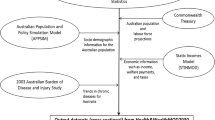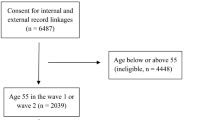Abstract
Objective: To estimate the cost of lost work days due to ischaemic heart disease (IHD), and the cost of this reduced productivity using reduction in household income.
Design and setting: Using 2 years of nationally representative observational data, this study examined the effect on household income of IHD. This effect was estimated after accounting for unemployment, days lost to illness and other effects of illness on the income of workers aged 18 to 64 years.
Main outcome measures and results: Previous measures of indirect costs of disease have typically not included the loss in productivity due to suboptimal work performance. Among workers in this age group, IHD was associated with a reduction of $US3013 in annual household income; this reduction was independent of occupational class, age, size of household and educational level. Such a reduction may be because of reduced on-the-job performance, employer perception of this, or unrelated lifestyle choices. It represents an estimated $US6.05 billion annual loss in productivity in 1992 dollars (or $US6.45 billion in 1996 dollars).
Conclusions: Estimates of the indirect costs of chronic disease that do not account fully for the lost income of employees may significantly underestimate the benefits to employers and society of treatment and prevention.


Similar content being viewed by others
References
Benson V, Marano MA. Current estimates from the National Health Interview Survey, 1993. National Center for Health Statistics. Vital Health Stat 1995; 10 (190): 1–221
Isacsson S-O. Ischemic heart disease: disability and costs. Qual Life Res 1994; 3 (1): S93–6
Hartunian NS, Smart CN, Thompson MS. The incidence and economic costs of cancer, motor vehicle injuries, coronary heart disease, and stroke: a comparative analysis. AmJ Public Health 1980; 70 (12): 1249–60
Jönsson B. Measurement of health outcome and associated costs in cardiovascular disease. Eur Heart J 1996; 17 Suppl. A: 2–7
Pestana JAX, Steyn K, Leiman A, et al. The direct and indirect costs of cardiovascular disease in South Africa in 1991. S Afr Med J 1996; 86 (6): 679–84
American Heart Association. 1997 Heart and Stroke Statistical Update. Dallas (TX): American Heart Association, 1997
Koopmanschap MA, van Ineveld BM. Towards a new approach for estimating indirect costs of disease. Soc Sci Med 1992; 34 (9): 1005–10
Posnett J, Jan S. Indirect cost in economic evaluation: the opportunity cost of unpaid inputs. Health Econ 1996; 5: 13–23
Rizzo JA, Abbott TA, Pashko S. productivity effects of prescribed medicines for chronically ill workers. Health Econ 1996; 5: 249–65
Stern S. Measuring the effect of disability on labor force participation. J Human Resources 1989; 24: 361–95
Koopmanschap MA, Rutten FFH. Indirect costs: the consequence of production loss or increased cost of production. Med Care 1996; 34 (12): DS59–68
Luft HS. The impact of poor health on earnings. Rev Econ Stat 1975; 57: 43–57
Kottke TE, Puska P, Feldman R, et al.Adecline in earning losses associated with a community-based cardiovascular disease prevention project. Med Care 1982; 20 (7): 663–75
Bartel A, Taubman P. Health and labor market success: the role of various diseases. Rev Econ Stat 1979; 61: 1–8
Massey JT, Moore TF, Parsons VL, et al. Design and estimation for the National Health Interview Survey, 1985–1994. National Center for Health Statistics. Vital Health Stat 1989; 2 (110): 1–33
U.S. Census Bureau. Historical income tables: households. Last revised 29 September 1997. Available from http://www.census.gov/hhes/income/histinc/h01.html [Accessed 2000 Feb 16]
Polachek SW, Siebert WS. The economics of earnings. Cambridge: Cambridge University Press, 1993
Botman SL, Jack SS. Combining National Health Interview Survey datasets: issues and approaches. Stat Med 1995; 14: 669–77
Stata Corporation. Stata Statistical Software: release 5.0. College Station (TX): Stata Corporation, 1997
Davis JM. Impact of health on earnings and labor market activity. Month Labor Rev 1972; 95: 46–9
Bound J. Self-reported versus objective measures of health in retirement models. J Hum Resources 1991; 26: 106–38
Russell LB. Is prevention better than cure? Washington, DC: The Brookings Institution, 1986
Gerard K, Mooney G. QALY league tables: handle with care. Health Econ 1993; 2: 59–64
Brouwer WB, Koopmanschap MA, Rutten FF. Productivity losses without absence: measurement validation and empirical evidence. Health Policy 1999; 48: 13–27
Acknowledgements
In addition to support for the authors from their own respective institutions, this research was supported in part by an unrestricted grant from Merck and Co. to the Kerr L. White Institute for Health Services Research. The authors would like to acknowledge the contributions of Sean Murphy, M.A., data analyst, and Lesley D. Wood, M.A. and Carissa A. Craig, manuscript editors. In addition, we appreciate the effort of the 2 anonymous reviewers whose comments and suggestions improved the manuscript.
Author information
Authors and Affiliations
Corresponding author
Rights and permissions
About this article
Cite this article
Herrin, J., Cangialose, C.B., Boccuzzi, S.J. et al. Household Income Losses Associated With Ischaemic Heart Disease For US Employees. Pharmacoeconomics 17, 304–314 (2000). https://doi.org/10.2165/00019053-200017030-00008
Published:
Issue Date:
DOI: https://doi.org/10.2165/00019053-200017030-00008




